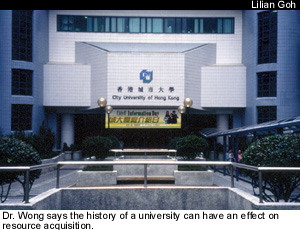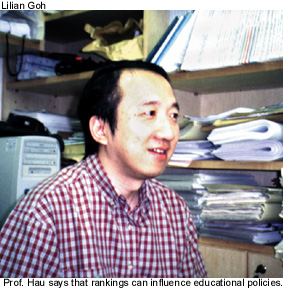The universities were ranked on the basis of five criteria — academic reputation, student selectivity, faculty resources, research and financial resources.
Dr. Wong Kam Cheung is the head of Department of Education at the University of Hong Kong.
“To me, this ranking report is just as entertaining as a beauty contest.
“I don’t think that the ranking is very reliable, even though the survey was seriously conducted,” Dr. Wong said.
Dr. Wong criticised the methodology used in the report. He thought the criteria used may be unfair to some universities.
“For example, universities in developing countries are granted less funding,” said he.
 Dr.
Wong thought that the history of a university also affects its resources
acquisition and academic reputation.
Dr.
Wong thought that the history of a university also affects its resources
acquisition and academic reputation.
“An early established university always edges out new universities in gaining appreciation and resource acquisition,” he said.
Dr. Wong regarded student selectivity, another criterion, as irrelevant to the quality of education.
“There are only seven universities in Hong Kong. The competition for places among students is therefore keen,” Dr. Wong said.
This is because these universities publish in Chinese journals and are therefore unlikely to get international recognition.
Prof. Hau Kit Tai is chairman of Department of Educational Psychology at The Chinese University of Hong Kong.
He agreed with the irrelevance of the number of journal publications to the quality of education.
“Universities can divide their journal articles or research reports into a few pieces and then publish them separately,” Prof. Hau said.
He also said it was nonsense to sum up unrelated things and calculate an average.
“Rankings should highlight the scores on each criterion, rather than the overall scores,” Prof. Hau said.
He criticised the criterion of financial resources. “Some departments or programmes require more resources.
“If the total spending per student is taken into account, universities that do not run these programmes would get a smaller value,”
He said there is no perfect ranking report.
“Quality cannot be quantified,” said Prof. Hau.
Mr. Shum Kwok Cheung is the project co-ordinator of the Hong Kong Institute of Asia-Pacific Studies.
He also doubted the validity of such measurement.
“People never think in the same way.
“It is difficult to find a compromise among agencies, readers and universities,” said Mr. Shum.
Miss Teresa Lai is a Year 1 student at The Chinese University of Hong Kong.
“The learning atmosphere is crucial, as well as a diversified education system,” said Miss Lai.
 Miss
Cheung Hiu Lam, a Year 2 student at The Chinese University of Hong Kong,
said the quality of teaching staff should also be considered.
Miss
Cheung Hiu Lam, a Year 2 student at The Chinese University of Hong Kong,
said the quality of teaching staff should also be considered.
In regard to the impact of such reports, Dr. Wong said they had no effect on educational policies.
“These reports are only rough work,” Dr. Wong said.
However, the University Grant Committee allocates resources partly on the basis of quality, so it needs to have some basis for evaluating educational quality.
The main consideration of the UGC is value-added.
This is defined as the quality of the output minus that of the intake.
The UGC admits that conceptually this calculation is valid, but it is difficult to compute, except possibly within a narrow discipline.
Unlike Dr. Wong, Prof. Hau said education policies of a university
may be influenced by these university ranking reports. ![]()